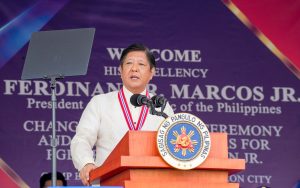Philippine President Ferdinand Marcos Jr. will make his first official visit to Washington on May 1, with the two nations’ expanding security relationship likely to form a good part of the agenda.
The White House first announced the trip back on April 20, stating that Biden will take the opportunity to “reaffirm the United States’ ironclad commitment to the defense of the Philippines.” The two leaders will also “review opportunities to deepen economic cooperation and promote inclusive prosperity, expand our nations’ special people-to-people ties, invest in the clean energy transition and the fight against climate change, and ensure respect for human rights,” the White House stated.
While there is much more to U.S.-Philippines relations than security, the Biden-Marcos summit punctuates a year that has seen swift advances in U.S.-Philippines defense relations, following the stagnation and frustration that took place under President Rodrigo Duterte. This has been marked by several milestones, including the expansion of the Enhanced Defense Cooperation Agreement (EDCA) to grant the U.S. military access to four additional Philippine military facilities, and the convening of the largest-ever Balikatan military exercise this month.
In comments to Reuters news agency, Jose Manuel Romualdez, the Philippine ambassador to the United States, said that economics and trade will form a good portion of the meeting, but that Marcos and Biden may also discuss tensions over Taiwan. These bear closely on the Philippines, given the fact that three of the four new bases earmarked for a rotational U.S. troop presence under EDCA are located in Luzon, close to the Taiwan Strait, and the fact that it is Chinese assertiveness in the South China Sea that has been the primary driver of rapid convergence between Washington and Manila.
Interestingly, Marcos also said this week that he plans to press Biden to make clear the extent of Washington’s commitment to protect his country under the 1951 Mutual Defense Treaty (MDT) that forms the core of the U.S.-Philippine alliance. “It (the treaty) needs to adjust because of the changes in the situation we are facing in the South China Sea, Taiwan, North Korea,” Marcos said in a radio interview, according to Reuters, adding that he and Biden should discuss how to manage tensions with China.
“What is our partnership? What can be done to tone down or reduce rhetoric? Because there have been an exchange of heated words,” he said of the relationship between Manila and Beijing.
Such demands for clarity about the scope of the MDT are not new. In the past, Philippine administrations asked the U.S. whether it extended to foreign attacks on the scattering of disputed islets and reefs claimed by the Philippines in the South China Sea, which were only formally incorporated in 1978 – a clarification that the Trump administration extended in 2019.
While it is hard to know whether Marcos was speaking off the cuff, his comment seems to concern less the extent of U.S. commitment to the Philippines than what the U.S. alliance might require of the Philippines. As U.S.-Philippine relations have consolidated apace, Manila has been presented with the challenge of managing a complex relationship with Beijing, which has been none too pleased about the galloping recent advancements in relations with Washington.
Earlier this month, the Chinese government declared that the Philippines was “stoking the fire” of regional tensions by agreeing to an expansion of EDCA, which allows the U.S. to use select military bases and their facilities on a rotational basis. The U.S. government was seeking to use the bases “to interfere in the situation across the Taiwan Strait to serve its geopolitical goals, and advance its anti-China agenda at the expense of peace and development of the Philippines and the region at large.” (While the Chinese rhetoric is overblown, the U.S. claim that EDCA “is not about any other third country” is also not easy to take at face value.)
As a result, Chinese and Philippine officials have held a number of recent discussions in order to prevent the current disagreement from prompting a full-blown crisis. Most recently, Philippine Foreign Affairs Secretary Enrique Manalo met last week with his Chinese counterpart Qin Gang in Manila, during which the two sides pledged “to work together to resolve their maritime differences in the South China Sea.” The two sides’ clashing claims in the South China Sea “should not prevent us from seeking ways of managing them effectively, especially with respect to enjoyment of rights of Filipinos, especially fishermen,” Manalo said, referring to incidents in which Chinese coast guard and maritime militia vessels have driven fishermen away from disputed features in the South China Sea.
Despite the recent expansion of security relations, each side has pursued this for their own reasons, with the U.S. seeking to create a bulwark against growing Chinese power and the Philippines concerned mostly about maritime and territorial disputes in the South China Sea.
As I’ve noted previously, while these interests overlap to a large extent, there is also probably a natural outer limit to the rapidly expanding U.S.-Philippine security partnership. Marcos’ comments could suggest that these boundaries may be starting to come into view.

































